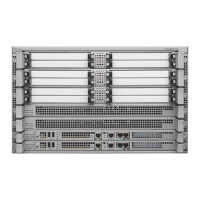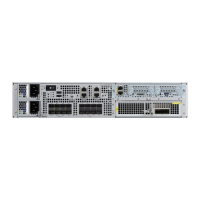10-9
Cisco ASR 1000 Series Aggregation Services Routers SIP and SPA Software Configuration Guide
OL-14127-08
Chapter 10 Configuring the Ethernet SPAs
Configuration Tasks
Router(config-if)# plim qos input map mpls exp
exp-value | exp-range queue low-latency | 0
Classifies incoming MPLS traffic according to the
value of the exp bits and places the traffic into the
appropriate queue.
• exp-value | exp-range—Specifies which
MPLS exp value or range to use.
• low-latency—Specifies high priority MPLS
traffic. Enter 0 for low priority.
By default, without using this command, the
Gigabit Ethernet SPA classifies MPLS EXP range
6-7 as high priority.
The no form of this command sets the
classification according to default exp range 6-7.
Router(config-if)# plim qos input queue
low-latency | 0 pause [enable | threshold
percent]
Enables Ethernet pause frame generation due to
flow control status.
• low latency—Specifies high priority queue.
Enter 0 for a low priority queue.
• pause—Sets up the queue threshold to send a
pause frame, which is a percentage of queue
limit for packet drop.
• The default threshold is 90 percent.
By default, without using the command, pause
frame generation is enabled for low latency
queue.
The no form of this command disables pause
generation for a queue.
Router(config-if)# plim qos input [bandwidth
value_in_Kbps [low-latency]] [weight weight]
Specifies the whole port, regardless of priority, or
specifies priority only (low-latency) to receive
minimum bandwidth guarantee, what minimum
bandwidth is demanded, and what weight value is
assigned for the excess scheduling.
The default mode (without using this command) is
that minimum scheduling is off and only excess
scheduling is in service, which uses default weight
proportional to the interface bandwidth.
The no form of this command sets the interface to
the default minimum bandwidth and weight.
Command Purpose

